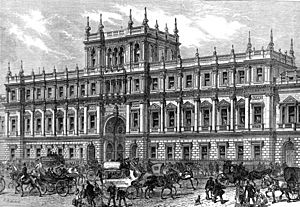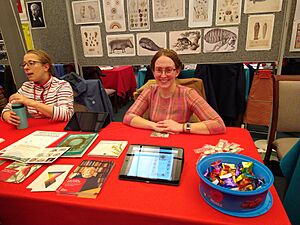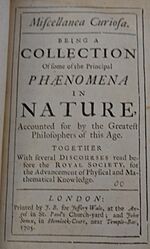Royal Society facts for kids
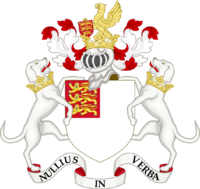
|
|
| Formation | 28 November 1660 |
|---|---|
| Headquarters | London, SW1 United Kingdom |
|
Membership
|
|
|
Patron
|
Charles III |
|
President
|
Sir Adrian Smith |
|
Foreign Secretary
|
Mark Walport and Alison Noble (jointly) |
|
Treasurer
|
Jonathan Keating |
|
Main organ
|
Council |
|
Staff
|
~225 |
| Remarks | Motto: Nullius in verba ("Take nobody's word for it") |
The Royal Society is a very old and important group of scientists in the United Kingdom. Its full name is The Royal Society of London for Improving Natural Knowledge. It acts as the UK's national academy of sciences.
The Royal Society does many things. It helps promote science and shows how science can benefit everyone. It also celebrates great scientists and supports new research. The society gives scientific advice to the government and helps teach people about science. It also works with scientists all over the world.
The Royal Society was started on 28 November 1660. King Charles II gave it a special document called a royal charter. This made it official. It is the oldest science academy in the world that has been working continuously since it began.
The society is run by its Council, which is led by the President. Members of the Council and the President are chosen by the society's main members, called Fellows. Fellows are also chosen by other Fellows. As of 2020, there were about 1,700 Fellows. They can use the letters FRS after their name, which stands for Fellow of the Royal Society. Each year, up to 73 new Fellows are chosen. There are also Royal Fellows, honorary Fellows, and Foreign Members.
Since 1967, the Royal Society has been located at 6–9 Carlton House Terrace in central London. This is a very old and important building.
Contents
History of the Royal Society
How the Royal Society Began
Before the Royal Society officially started, there was a group of thinkers called the "Invisible College." These were scientists like Robert Boyle. They believed in learning through experiments. This idea was similar to Francis Bacon's "House of Solomon," a place for scientific research.
In the mid-1600s, groups of doctors and scientists met in places like Gresham College in London and Wadham College in Oxford. They were inspired by new ways of thinking about science. These groups helped lead to the creation of the Royal Society.
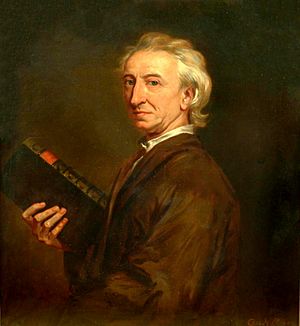
On 28 November 1660, 12 scientists met at Gresham College. They decided to create a "Colledge for the Promoting of Physico-Mathematicall Experimentall Learning." Among them were famous people like Christopher Wren and Robert Boyle. This date is seen as the official start of the Royal Society.
Soon after, King Charles II approved their meetings. On 15 July 1662, he signed a royal charter. This officially created the "Royal Society of London." Lord Brouncker became the first president. A second charter was signed on 23 April 1663. This charter named the King as the founder. The society's name became "the Royal Society of London for the Improvement of Natural Knowledge." Robert Hooke was hired to do experiments. Since then, every British monarch has supported the society.
In its early days, the society held meetings where experiments were shown. These experiments covered many different topics. The society also published an English translation of an Italian book about experiments. After the Great Fire of London in 1666, the society temporarily moved. It returned to Gresham College in 1673.
There was an idea in 1667 to build a special "college" for the society. This would have been a dedicated place for research and discussion. However, these plans never happened because there wasn't enough money from the members.
The 1700s

In the 1700s, the excitement of the early years calmed down a bit. However, the society's reputation grew stronger, especially under the leadership of Isaac Newton. He was president from 1703 until he passed away in 1727. During this time, the society's scientific journal, Philosophical Transactions of the Royal Society, was published regularly.
The government also started asking the Royal Society for scientific advice. This is something the society still does today. For example, in 1777, there was a debate about which type of lightning conductor to use. The society was asked for its opinion.
The number of Fellows grew from about 110 to 300 by 1739. In 1705, the society had to find a new home. They bought two houses in Crane Court, Fleet Street, in 1710. These houses had offices and space for their collections. Even though many Fellows didn't pay their fees on time, the society continued its work. They showed experiments and discussed important scientific papers.
In 1780, the society moved again to Somerset House. The government offered them this new location. While it was bigger, it still wasn't perfect. The library was too small, and there wasn't enough space for their museum. So, the museum collection was given to the British Museum in 1781.
The 1800s
In the early 1800s, some people felt the society was not doing as well. In 1830, Charles Babbage wrote a book criticizing the society. This made the scientific Fellows take action. They decided to change how new members were chosen.
A committee suggested that Fellows should be chosen based on their scientific achievements. They also limited the number of new Fellows elected each year. This helped make the society's members almost entirely scientists. The total number of Fellows became more stable, usually between 400 and 500.
Important changes were made to the society's rules. For example, the Treasurer had to publish a yearly report of the society's money. This helped ensure that the leaders were doing a good job.
In 1850, the society started managing money from the government to support scientific research. This grant has grown a lot over the years. Today, it is over £47 million and helps fund many research projects and scientists.
By 1852, the society needed more space at Somerset House. The government decided to move several scientific societies, including the Royal Society, to Burlington House. The Royal Society moved there in 1873.
The 1900s
On 22 March 1945, the first women were elected as Fellows of the Royal Society. This happened after a rule change in 1944 that said women could be candidates. Marjory Stephenson and Kathleen Lonsdale were the first two women chosen.
In 1947, Mary Cartwright became the first female mathematician to be elected a Fellow. She was also the first woman to serve on the Royal Society's Council.
Because Burlington House became too crowded, the society moved to Carlton House Terrace in 1967.
The 2000s
In recent years, the Royal Society has continued its important work. For example, during the COVID-19 pandemic, the society worked to share accurate scientific information. They aimed to help people understand the science behind vaccines and fight against false information.
Coat of Arms
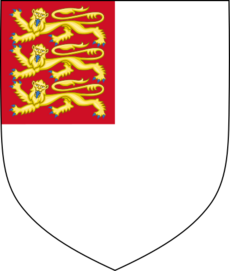
The Royal Society has its own special coat of arms. It shows three lions, which are the Lions of England. Above the shield is an eagle holding another shield with the three lions. The supporters, which hold up the shield, are two white hounds wearing crowns.
The society's motto, Nullius in verba, is also part of the coat of arms. It means "Take nobody's word for it." This motto shows that the society believes in finding facts through experiments, not just by believing what others say.
King Charles II approved the design of the coat of arms in 1662. It was officially granted to the society when the second charter was signed in 1663.
Charter Book
When new Fellows and Foreign Members join the Royal Society, they must sign a special book. This book is called the Charter Book. People have been signing it continuously since 1663. All British monarchs since then have signed the book, except for William and Mary, and Queen Anne. In 2019, the book was made available digitally.
Motto
The Royal Society's motto is Nullius in verba. It is a Latin phrase that means "Take nobody's word for it." This motto was chosen to show that the Fellows are determined to find facts through experiments. It comes from an ancient Roman writer named Horace.
Fellows of the Royal Society (FRS)
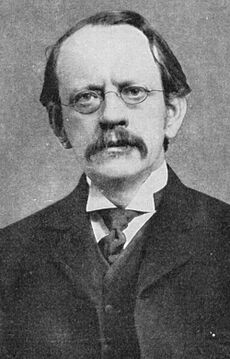
The main members of the Royal Society are called Fellows. They are scientists and engineers from the UK and Commonwealth countries. They are chosen because they have made "a substantial contribution to the improvement of natural knowledge." This includes work in mathematics, engineering, and medical science.
Once elected, Fellows are members for life. They can use the letters FRS after their name. Fellows also help the society financially and can vote for new Fellows and leaders. Up to 52 new Fellows are elected each year. In 2014, there were about 1,450 living Fellows. Existing Fellows choose new members through special committees.
The society also has other types of members:
- Royal Fellows are members of the British royal family. They represent the monarchy's support for the society. There are currently four Royal Fellows, including The King of the United Kingdom and The Prince of Wales.
- Honorary Fellows are people who have greatly helped science or the society, even if they are not scientists themselves.
- Foreign Members are scientists from other countries who are famous for their scientific discoveries. Eight are elected each year. They can use the letters ForMemRS after their name. As of August 2020, there were about 185 Foreign Members.

The first Fellows were chosen in 1663. Many early Fellows were not scientists. This was because the society needed support from wealthy or important people to survive. Over time, as the society became more financially stable, it began to focus on electing only scientists. By the mid-1800s, it was decided that new members would be chosen based on their scientific achievements.
How the Royal Society is Run
The Royal Society is managed by its Council. The Council is led by the society's President. The members of the Council, the President, and other leaders are elected by the Fellows.
The Council
The Council is made up of 20 to 24 Fellows. This includes the President, Treasurer, two Secretaries (one for physical sciences and one for life sciences), and the Foreign Secretary. The Council guides the society's overall plans and manages its daily business. They also look after the society's property. Members of the Council are elected every year. The Council also has many committees that help with its work.
The current leaders are:
- President: Sir Adrian Smith
- Treasurer: Jonathan Keating
- Biological Secretary: Linda Partridge
- Physical Secretary: Sheila Rowan
- Foreign Secretary: Sir Mark Walport and Alison Noble (jointly)
The President
The President of the Royal Society is the main leader of the society and the Council. The President serves for five years.
The current President is Adrian Smith. He took over from Venki Ramakrishnan on 30 November 2020. The President has many duties. They act as the government's main advisor on scientific matters. They also welcome important guests and scientists from other countries.
Staff Members
The Royal Society has many full-time paid staff who help run the organization. In the past, they had people to do experiments and manage their book collection. As the society grew, so did its staff. The current executive director is Dame Julie Maxton DBE.
What the Royal Society Does
The Royal Society does many important things. It supports modern science by giving out over £100 million. This money helps fund nearly 1,000 research fellowships for scientists at different stages of their careers. It also provides grants for new ideas and research.
The society gives out many awards, lectures, and medals to celebrate scientific achievements. These often come with prize money to help fund more research. The society also helps scientists learn how to talk about their work to the public and the media. Much of this work is supported by money from the UK government.
Through its Science Policy Centre, the society advises the UK Government, the European Commission, and the United Nations on science topics. It publishes reports and acts as the national Academy of Sciences for the UK. The government has regularly asked the society for scientific advice since the 18th century.
Carlton House Terrace
The building at 6–9 Carlton House Terrace is a very important historical building. It is the current home of the Royal Society. The society moved there from Burlington House in 1967.
The ground floor and basement are used for events and ceremonies. The first floor has special rooms for Fellows and leaders of the society. The upper floors have offices and living spaces for the President and other staff.
John Nash designed Carlton House Terrace. The building is still owned by the Crown Estates and leased by the society. It was renovated from 2001 to 2004 and reopened by the Prince of Wales on 7 July 2004. The renovations made the building more modern and easier to use.
Publishing Scientific Journals
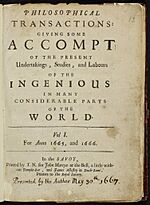
The Royal Society publishes many scientific journals through Royal Society Publishing. These journals share new research with the world.
In 1665, the society started the world's first journal just for science, called Philosophical Transactions. This journal also started the idea of peer review. In peer review, other experts check a scientific paper before it is published. This helps make sure the research is good.
Philosophical Transactions is the oldest and longest-running scientific journal in the world. Since 1886, it has been divided into two parts:
- Part A: For mathematics and physical sciences.
- Part B: For biological sciences.
Other journals published by the society include:
- Proceedings of the Royal Society A
- Proceedings of the Royal Society B
- Biology Letters
- Open Biology
- Royal Society Open Science
- Journal of the Royal Society Interface
- Interface Focus
- Notes and Records (about the history of science)
- Biographical Memoirs (obituaries of deceased Fellows)
All of the society's journals use peer review. In May 2021, the society announced plans to make its research journals open access. This means the research will be free for everyone to read online.
Awards and Honours
The Royal Society gives out many awards, lectures, and medals to celebrate great scientific achievements. The oldest award is the Croonian Lecture. It was created in 1701 and is given every year. It is considered the most important Royal Society prize for biological sciences.
The Copley Medal is the oldest Royal Society medal still given out. It is awarded for "outstanding achievements in research in any branch of science."
See also
 In Spanish: Royal Society para niños
In Spanish: Royal Society para niños
- Royal Fellows of the Royal Society
- List of Fellows of the Royal Society
- List of female Fellows of the Royal Society
- List of presidents of the Royal Society
- Academy of Medical Sciences
- British Academy
- British Association for the Advancement of Science
- Laputa, a fictional island in Gulliver's Travels that made fun of the Royal Society.
- List of British professional bodies
- List of Royal Societies
- Royal Institution
- Royal Academy of Engineering
- Society Islands
- The Baroque Cycle, a series of historical novels where many Royal Society founders appear.
- The Royal Society Range, a mountain range in Antarctica named after the society
- UK Young Academy




